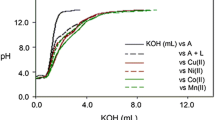Abstract
The spectral and calorimetric data on complex formation between alkyl substituted a,c-biladiene and Ni(II), Cu(II), Zn(II), Cd(II), and Hg(II) acetates in dimethylformamide are discussed. The stability of mononuclear biladiene chelates was shown to be determined by steric factors characterizing the formation of coordination polyhedra with the tetradentate ligand. The thermodynamic characteristics of the differential polychelate effect caused by the replacement of the bidentate dipyrrolylmetene ligand with the tetradentate biladiene anion in mononuclear zinc(II) complexes were estimated. The results showed that the largest contribution to the polychelate effect was made by the enthalpy component of the Gibbs energy.
Similar content being viewed by others
References
H. Falk, The Chemistry of Linear Oligopyrroles and Bile Pigments (New York, 1989).
S. Halper, M. Malachowski, H. Delaney, and S. Cohen, Inorg. Chem. 43(4), 1242 (2004).
A. Thompson and D. Dolphin, J. Org. Chem. 65(23), 7870 (2000).
B. D. Berezin, Coordination Compounds of Porphyrins and Phthalocyanine (Nauka, Moscow, 1978; Wiley, New York, 1981).
Comprehensive Organic Chemistry: The Synthesis and Reactions of Organic Compounds, Ed. by D. H. R. Barton and W. D. Ollis, Vol. 8: Nitrogen-Containing Heterocycles (Pergamon, Oxford, 1979; Khimiya, Moscow, 1985).
A. Thompson and D. Dolphin, Org. Lett. 2(9), 1315 (2000).
T. Wood, A. Ross, D. Dalgleish, et al., J. Org. Chem. 70(24), 9967 (2005).
T. Wood, N. D. Dalgleish, E. Power, and A. Thompson, J. Am. Chem. Soc. 127(16), 5740 (2005).
B. Tu, B. Ghosh, and D. Lighter, J. Org. Chem. 68(23), 8950 (2003).
E. V. Antina, M. B. Berezin, G. B. Guseva, et al., in Chemistry of Solutions and Technology of Liquid-Phase Materials: Advances and Prospects (Inst. Khim. Rastvorov, Ross. Akad. Nauk, Ivanovo, 2006), p. 105 [in Russian].
E. V. Antina, S. P. Zakharova, and E. V. Rumyantsev, Zh. Obshch. Khim. 76(7), 1205 (2006) [Russ. J. Gen. Chem. 76 (7), 1157 (2006)].
S. P. Zakharova, E. V. Rumyantsev, E. V. Antina, and A. S. Semeikin, Koord. Khim. 31(5), 353 (2005) [Russ. J. Coord. Chem. 31 (5), 331 (2005)].
S. P. Zakharova, E. V. Rumyantsev, and E. V. Antina, Koord. Khim. 31(12), 895 (2005) [Russ. J. Coord. Chem. 31 (12), 849 (2005)].
E. V. Antina, S. P. Zakharova, and E. V. Rumyantsev, Koord. Khim. 32(7), 547 (2006) [Russ. J. Coord. Chem. 32 (7), 524 (2006)].
G. B. Guseva, E. V. Antina, M. B. Berezin, et al., Zh. Obshch. Khim. 72(1), 135 (2002) [Russ. J. Gen. Chem. 72 (1), 126 (2002)].
W. W. Wendlandt, Thermal Methods of Analysis, Vol. 19 of Chemical Analysis (Wiley, New York, 1974; Mir, Moscow, 1978).
A. Weissberger, E. S. Proskauer, J. A. Riddick, and E. E. Toops, Organic Solvents: Physical Properties and Methods of Purification, Vol. 7 of Techniques in Modern Chemistry (Interscience, New York, 1955; Inostrannaya Literatura, Moscow, 1958).
A. I. V’yugin, Extended Abstract of Doctoral Dissertation in Chemistry (Inst. of Chem. of Nonaqueous Solutions, USSR Acad. Sci., Ivanovo, 1991).
E. V. Rumyantsev, S. P. Zakharova, G. B. Guseva, et al., Zh. Fiz. Khim. 78(12), 2188 (2004) [Russ. J. Phys. Chem. 78 (12), 1936 (2004)].
O. A. Golubchikov and B. D. Berezin, Zh. Fiz. Khim. 60(9), 2113 (1986).
O. A. Golubchikov, Extended Abstract of Doctoral Dissertation in Chemistry (Inst. of Chem. of Nonaqueous Solutions, USSR Acad. Sci., Ivanovo, 1985).
Chemistry of Coordination Compounds, Ed. by N. A. Kostromina (Vysshaya Shkola, Moscow, 1990) [in Russian].
Metal Complexons and Complexonates, Ed. by N. M. Dyatlov, V. Ya. Temkin, and K. I. Popov (Khimiya, Moscow, 1988) [in Russian].
Physical Methods for Studies of Inorganic Substances, Ed. by A. B. Nikol’skii (Izd. Tsentr “Akademiya,” Moscow, 2006) [in Russian].
B. D. Berezin, D. B. Berezin, and M. B. Berezin, Ross. Khim. Zh. 41(3), 105 (1997).
G. B. Guseva, E. V. Antina, N. A. Dudina, and A. I. V’yugin, Abstracts of Papers, All-Russia Conference “Natural Macrocyclic Compounds and Their Synthetic Analogues” (Syktyvkar, 2007), p. 47.
V. N. Kumok, Rules Governing the Stability of Coordination Compounds in Solution (Tomsk. Gos. Univ., Tomsk, 1977) [in Russian].
Author information
Authors and Affiliations
Corresponding author
Additional information
Original Russian Text © S.P. Makarova, E.V. Rumyantsev, E.V. Antina, 2008, published in Zhurnal Fizicheskoi Khimii, 2008, Vol. 82, No. 12, pp. 2255–2259.
Rights and permissions
About this article
Cite this article
Makarova, S.P., Rumyantsev, E.V. & Antina, E.V. The thermodynamic characteristics of formation of mono-and binuclear biladiene Ni(II), Cu(II), Zn(II), Cd(II), and Hg(II) chelates in dimethylformamide solutions. Russ. J. Phys. Chem. 82, 2030–2034 (2008). https://doi.org/10.1134/S0036024408120108
Received:
Published:
Issue Date:
DOI: https://doi.org/10.1134/S0036024408120108



